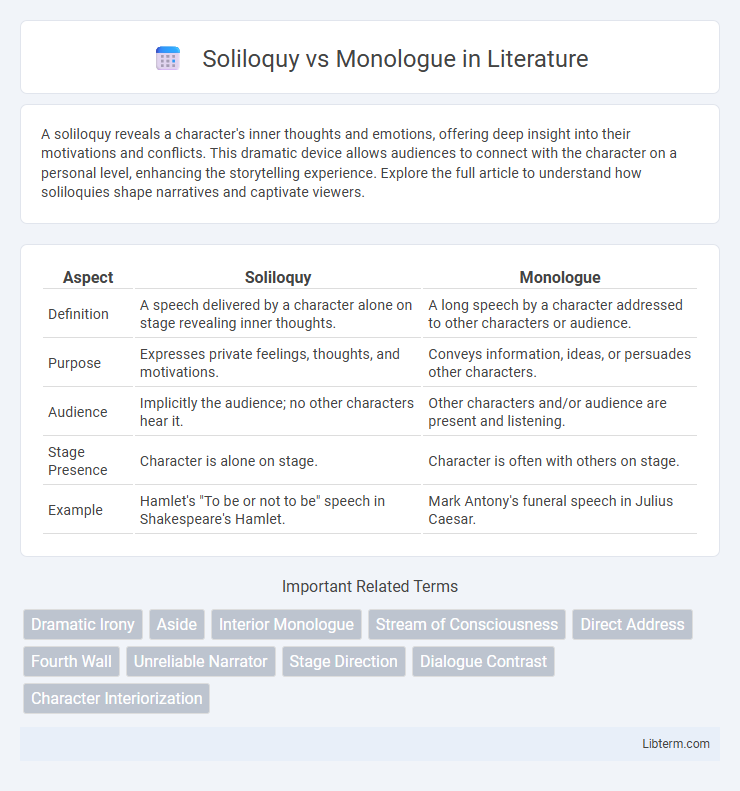A soliloquy reveals a character's inner thoughts and emotions, offering deep insight into their motivations and conflicts. This dramatic device allows audiences to connect with the character on a personal level, enhancing the storytelling experience. Explore the full article to understand how soliloquies shape narratives and captivate viewers.
Table of Comparison
| Aspect | Soliloquy | Monologue |
|---|---|---|
| Definition | A speech delivered by a character alone on stage revealing inner thoughts. | A long speech by a character addressed to other characters or audience. |
| Purpose | Expresses private feelings, thoughts, and motivations. | Conveys information, ideas, or persuades other characters. |
| Audience | Implicitly the audience; no other characters hear it. | Other characters and/or audience are present and listening. |
| Stage Presence | Character is alone on stage. | Character is often with others on stage. |
| Example | Hamlet's "To be or not to be" speech in Shakespeare's Hamlet. | Mark Antony's funeral speech in Julius Caesar. |
Understanding Soliloquy and Monologue
Soliloquy is a dramatic device where a character speaks their inner thoughts aloud, often alone on stage, revealing private emotions and motivations directly to the audience. Monologue involves a single character delivering an extended speech to other characters, advancing the plot or providing insight without breaking the narrative flow. Understanding the distinction highlights soliloquy's introspective nature versus monologue's communicative function in storytelling.
Definitions: Soliloquy vs Monologue
A soliloquy is a dramatic device where a character speaks their thoughts aloud while alone on stage, revealing inner feelings to the audience without addressing other characters. A monologue is an extended speech by a single character directed to other characters or the audience within a play or performance. Both techniques provide insight into a character's mind, but soliloquies are introspective, whereas monologues are often intended for communication or persuasion.
Key Differences Between Soliloquy and Monologue
A soliloquy reveals a character's inner thoughts and emotions directly to the audience, often when the character is alone on stage, providing insight into their personal motivations. In contrast, a monologue involves one character speaking at length to other characters, advancing the plot or developing relationships within the scene. While soliloquies emphasize introspection and internal conflict, monologues focus on communication and interaction with others.
Historical Origins and Literary Evolution
Soliloquy originated in classical Greek drama as a technique for characters to reveal their innermost thoughts directly to the audience, while monologues emerged as extended speeches within plays, serving various dramatic purposes. During the Renaissance, soliloquies gained prominence in Shakespearean works, evolving into a nuanced device for psychological exploration, whereas monologues expanded to include persuasive or narrative elements across theatrical traditions. Both forms have historically shaped character development, with soliloquies emphasizing introspection and monologues enhancing dialogue-driven storytelling.
Purpose and Function in Dramatic Literature
Soliloquies serve to reveal a character's innermost thoughts and emotions directly to the audience, providing deep psychological insight and advancing the narrative through personal reflection. Monologues, while also lengthy speeches, function primarily to express a character's intentions, persuade other characters, or convey important information within the social context of the play. Both devices enhance dramatic tension but differ in purpose: soliloquies inwardly explore, whereas monologues outwardly communicate.
Famous Examples in Classic Plays
Soliloquies, such as Hamlet's "To be or not to be" in Shakespeare's *Hamlet*, reveal a character's inner thoughts and emotions directly to the audience, unlike monologues which are delivered to other characters within the play. Another famed soliloquy is Macbeth's "Is this a dagger" passage from *Macbeth*, showcasing intense psychological conflict. Famous monologues include Mark Antony's "Friends, Romans, countrymen" speech in *Julius Caesar*, where persuasive rhetoric is used to influence other characters on stage.
Soliloquy: Inner Thoughts and Personal Reflection
Soliloquy reveals a character's innermost thoughts and personal reflections, providing direct insight into their emotions and motivations. Unlike a monologue, which is addressed to other characters or the audience, a soliloquy is spoken when the character is alone, emphasizing internal conflict and self-examination. This dramatic device enriches storytelling by exposing subconscious feelings and mental states that drive character development.
Monologue: Communication with Other Characters
Monologues are extended speeches delivered by a character to other characters, driving the narrative through direct communication and interaction. They reveal motivations, emotions, and conflicts, influencing the plot and character dynamics within the dialogue. Unlike soliloquies, monologues serve as a dynamic tool for character development in scenes involving multiple participants.
Impact on Audience Engagement and Interpretation
Soliloquies provide intimate insight into a character's inner thoughts, fostering a deep emotional connection and enhancing audience engagement through direct psychological exposure. Monologues, often delivered to other characters, drive plot development and reveal personality traits, shaping audience interpretation by contextualizing the speaker's motivations within the drama. The soliloquy's introspective nature invites personal reflection, whereas the monologue's external focus encourages analysis of character relationships and narrative dynamics.
Choosing Between Soliloquy and Monologue in Writing
Choosing between soliloquy and monologue in writing depends on the narrative purpose and character development needed. A soliloquy reveals a character's inner thoughts directly to the audience, creating intimacy and insight, ideal for psychological depth. Monologues, delivered to other characters or a crowd, emphasize persuasion, storytelling, or dramatic effect, enhancing dialogue-driven scenes and external conflict.
Soliloquy Infographic

 libterm.com
libterm.com